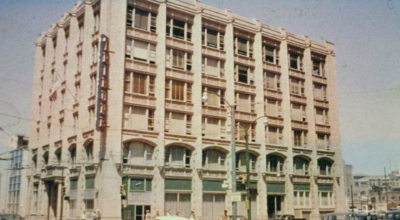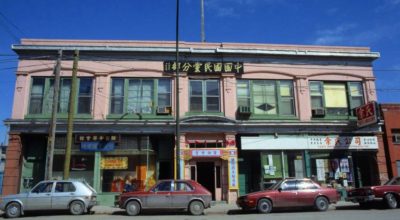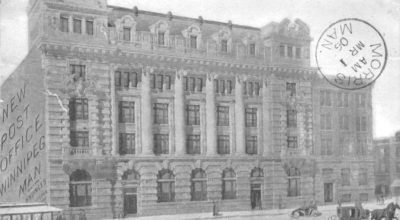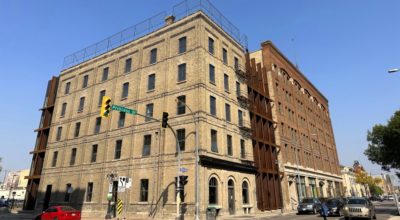
/ Blog
April 21, 2021
An Art Deco-rated History: 239 Selkirk Avenue
One of Winnipeg’s few Art Deco buildings stands at 239 Selkirk Avenue. Despite the 1930s façade, the building has a much longer connection to the community. The original building was constructed in 1889 as the North Presbyterian Church, replacing the church’s original building on Aberdeen Avenue. A congregation member, Architect John W. Grieve, designed the church in a modest Gothic Revival style, with an arched stained glass window and detailed brick corbelling along the roof line. The first service was held on December 1st, 1889, and was led by Reverend John Hogg. Rapid growth of the congregation prompted the addition of a balcony several years later, and it was renamed the St. Giles Presbyterian Church in 1895. By 1908, the church had outgrown the space completely and they moved to a new building at 294 Burrows Avenue which still stands today.
After the Presbyterian Church left the building on Selkirk Avenue, it was purchased by the Hebrew Sick Benefit Association (HSBA). The HSBA was a mutual aid organization, founded in the early 1900s, and was one of several organizations that provided social services to Jewish Winnipeggers in the years before the government provided social aid. Under their management, the former church was transformed into a theatre and meeting hall.
Architect Max Z. Blankstein designed the newly renovated space. This was Blankstein’s first official project in Manitoba; Blankstein, a Jewish-Russian immigrant, had fled Russia when the war broke out between Russia and Japan in 1904. After arriving in Canada, Blankstein took work on the railroad and sent for his wife and children, who arrived a year later in 1905. The family settled in Winnipeg, in an area of the North End nicknamed “New Jerusalem”. Much of Blankstein’s architectural work took place in this community, and many of his buildings can be found along Selkirk Avenue, Jarvis Street, and Main Street.
The HBSA Hall was Blankstein’s first project as an accredited architect. Many of the exterior gothic elements were removed, including the prominent stained glass window, replaced with a mission revival inspired curved parapet wall and more elaborate brickwork. The building’s name was changed to the Queen’s Theatre, and it established itself as a hub for Yiddish theatre in Manitoba. The surrounding neighbourhood on Selkirk Avenue was made up of predominantly Eastern-European and Jewish immigrants, resulting in a vibrant and interconnected community.
As such, the Queen’s Theatre regularly hosted community events and involved neighbourhood residents in their productions. Laurie Mainster, who grew up along Selkirk Avenue, got a walk-on role in a play at just four years old! Other shows brought in outside entertainment from across North America; there were musical numbers, dramatic productions, and even the occasional wrestling match was held at the theatre.
When not providing theatrical entertainment, the venue hosted labour meetings, community fundraisers, religious services and more. During the 1919 Winnipeg General Strike, the Queen’s Theatre was one of several venues used to host mass meetings for the strikers.
Like many other Winnipeg institutions, the Queen’s Theatre closed amidst the Great Depression in the 1930s. The HSBA retained ownership of the building but instead rented it out to the Polish National Church. By 1934, however, the building was vacant. This may have been somewhat of a blessing: in December of 1934 the building was heavily damaged by a fire. The fire broke out on the mezzanine level of the theatre and caused significant damage to the roof. The damage cost around $1,500.
Mr. A. Akman was hired to perform the repairs on the building in 1935; this work included repairing the roof, remodeling the interior, and updating the façade. Art Deco architecture is often cube-shaped, with geometric ornamentation. Exterior details, such as the windows or other ornamentation, tend to run vertically to highlight the length of the building. As an architectural style, Art Deco flourished across North America in the 1930s. Winnipeg’s economic stagnation at the time meant there was little money to spend on new building projects at the time, so there are just a handful of Art Deco buildings in the city – 239 Selkirk among them. The former Queen’s Theatre reopened in May of 1935.
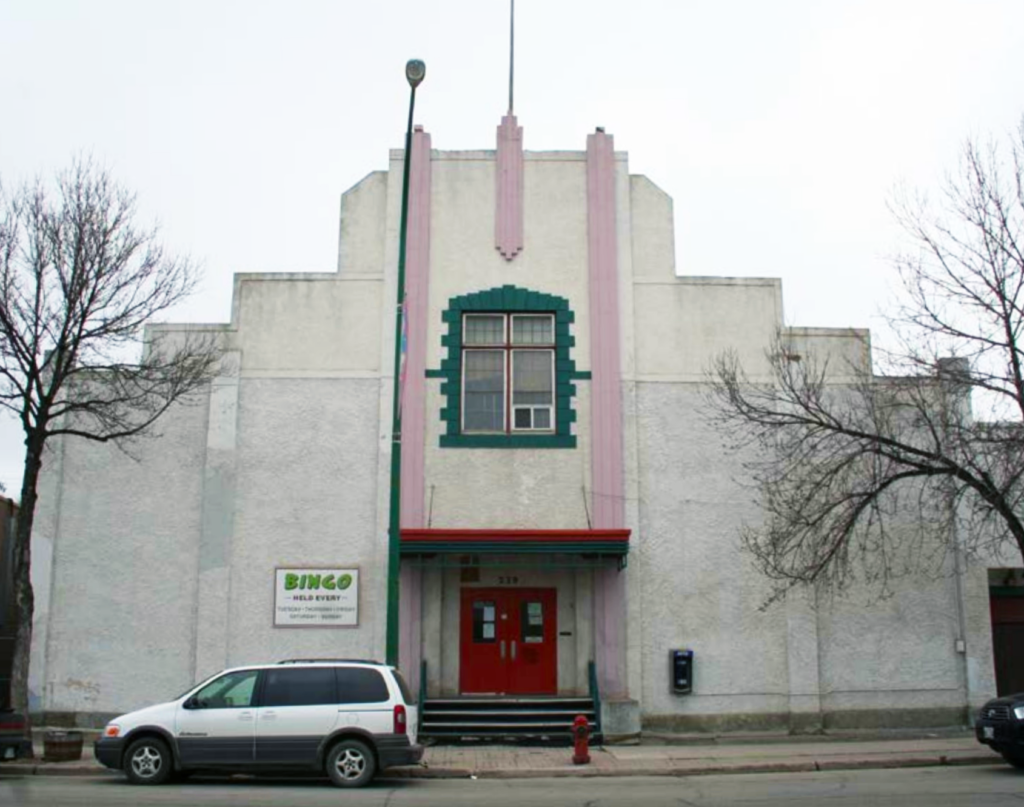
The art deco façade of the Queen’s Theatre.
Source: City of Winnipeg Historical Report.
In 1941, another fire struck the building. This time, it was believed the fire started due to an improperly disposed cigarette. Unlike the previous fire, the hall wasn’t vacant in 1941. The building’s caretaker, Charlie Stewart, lived in the basement suite with his wife and infant daughter. Stewart was the one who noticed and called in the fire, before sending his wife and child away to spend the night in a hotel. This time, the damages from the fire cost between $10,000 to $12,000. Insurance covered some of the costs, and as such only $9,000 was spent fixing the building.
The roof was repaired again, and the hall reopened in time for its Queen Esther fundraising festival in April. Once repairs were completed, the former Queen’s Theatre reopened as a community centre and later a bingo hall – mostly referred to the Hebrew Sick Benefit Hall. High Holidays were frequently celebrated in the building, as were Jewish weddings on Sundays. There were also stag-dos and card nights. Political rallies were also held at the H.S.B. Hall, such as an anti-Vietnam war rally in 1968 or meetings of the local Communist Party. Folk singer Pete Seeger even performed at the hall on October 11th, 1954.
Bingo remained the hall’s biggest draw for many decades. Behind the scenes, the Hebrew Sick Benefit Association was undergoing its own changes. In the 1960s, the HSBA merged with several other organizations to form the Beth Israel Synagogue and then, in 2002, the Beth Israel Synagogue merged with Bnay Abraham, and Rosh Pina to form Congregation Etz Chayim. Decreased bingo revenues prompted the group to sell the hall in 2010. It was purchased by the Church of the Rock, as the North End Campus. A year prior, in 2009, 239 Selkirk Avenue was added to the city’s commemorative list of historic buildings, which is a nice gesture but affords the building no real protection.
Selkirk Avenue is a distinct historic area in Winnipeg, with many physical connections to the immigrant communities who settled and thrived in the area across the early 20th century. The former Queen’s Theatre is a prominent reminder of this rich historical legacy!
THANK YOU TO THE SPONSOR OF THIS BLOG POST:

Written by Sabrina Janke on behalf of Heritage Winnipeg.
SOURCES:
239 Selkirk Avenue, City of Winnipeg Historical Resources
239 Selkirk Avenue - Former Queen's Theatre (Winnipeg Downtown Places)
Sharon Chisvin, Jewish theatre has long history in city, Winnipeg Free Press
Myron Love, Landmark Winnipeg Communal Hall Sold, Canadian Jewish News
Max Blankstein, Winnipeg Architecture Foundation
Winnipeg Tribune Files






